POTASSIUM PERMANGANATE
POTASSIUM PERMANGANATE: Potassium permanganate is a medication that is commonly used for skin infections and wounds. It is an oxidizing agent and antiseptic that helps to cleanse and disinfect the affected areas.
The mechanism of action of potassium permanganate is based on its ability to release oxygen when it comes into contact with water or body fluids. This results in the destruction of bacteria, fungi, and other microorganisms that may be present on the skin or in the wound. It is particularly effective against certain types of bacteria, such as Staphylococcus aureus.
Potassium permanganate is available in the form of a crystalline powder and can be dissolved in water to create a solution that is applied topically to the affected area. The concentration of the solution can vary depending on the severity of the infection or wound.
For skin infections, a potassium permanganate solution with a concentration of 0.1% to 0.5% is usually recommended. This solution is applied to the affected area for a short duration, typically around 10 minutes, before being rinsed off with water.
For wound care, a weaker concentration of 0.01% to 0.04% is typically used. The solution is applied to the wound and left in contact for a short period before being rinsed off.
It is important to note that potassium permanganate should be used under medical supervision, as improper use or application can cause skin irritation or burns. It should not be ingested or used on large areas of the body without proper guidance.
Common side effects of potassium permanganate include skin irritation, burning sensation, and dryness. In rare cases, individuals may experience allergic reactions such as itching, swelling, or difficulty breathing. If any severe or persistent side effects occur, medical attention should be sought immediately.
Overall, potassium permanganate is an effective antiseptic agent for treating skin infections and wounds. However, it should be used with caution and under the guidance of a healthcare professional to ensure proper application and minimize the risk of side effects.

